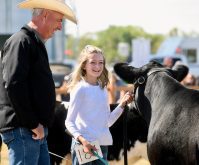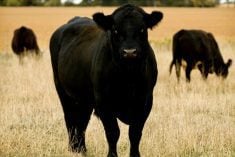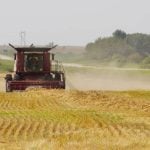NextGen Cattle Company is an American-owned cattle company based out of Paxico, Kansas, on the east side of the Flint Hills. It is owned and operated by three seasoned cattle producers who are using what they have learned through hands-on experience to bring about their vision.
In 2015, brothers Derek and Damon Thompson, along with their cousin Brad Lindstrom, started their cattle operation to produce the highest-quality beef. Matt Badsky is the chief financial officer. They started with seedstock so they could cover many divisions of the beef industry, with the goal of serving the commercial producer. They soon realized they needed to expand by adding feed lots, a packing plant and sales for their beef to be able to compete with commercial cattle operations.
The ranch carries 1,000 head of seed stock consisting of Angus, Charolais and Beefmasters.
Read Also

The Canadian Cattle Association’s international advocacy efforts
Global ag policies affect Canadian food policy, so the Canadian Cattle Association participates in international and domestic forums
NextGen has two bull sales annually with sales of 600 to 700 bulls each year. One of their two finishing feed yards has carried up to 60,000 head. NextGen also has a meat company and is starting a line of direct-to-consumer products. Their processing plant is in Pleasant Hope, Missouri, and processes 500 head of cattle daily.
The company has a simple buyback program. They buy the calves back from people who have bought their NextGen bulls. Next Gen finishes the calves and gives the information back to the customer.
This program reassures NextGen they are getting genetics that have already been proved in the feed yard and what comes to their packing plant. NextGen buys back calves between weaning time and yearling age. When a price is agreed upon, the calves are picked up.
NextGen has a seedstock herd of 800 registered females. Spring and fall calving coincide with the ranch’s two annual bull sales held in April and September. Registered females are included in the fall sale.
All NextGen’s bulls are developed at their facilities. After the calves are weaned the first round of culls is processed. The bulls are then fed on native grass during winter with rotating rations of corn, silage, hay, dried distiller grains and mineral.
All ingredients are locally grown except for the dried distiller grains. The bulls are at least 18 months old before being considered for sale. Semen testing is done when the bulls reach 16 to 17 months old.
From May to the beginning of November the cattle are put out to pasture to feed on the native grasses. “We will winter cows on the same grass and supplement with hay and some protein throughout the winter,” says Lindstrom.
“We are big believers in having the bulls out on grass for a period of time during their development. They can run on the Flint Hills and go out and travel. This will allow us to evaluate the soundness and structure of the bulls.
“With us being cattle feeders and having a packing plant, our genet- ics have to be able to perform on the rail without completely forgetting about creating the best replacement heifer we can.”
NextGen plans to have genetics supplied entirely from its feed yards by the continuous growth of the supply chain with its self-grown genetics.
NextGen has chosen the Charolais as the terminal breed. They like them for feeders due to their growth and marbling characteristics.
The Beefmaster is chosen because of the maternal traits they bear. “They make incredible cows and replacement females,” Lindstrom says. In designing an above-average female the Beefmaster crossed with most any other breed can create this outcome. They are exceptionally fertile and have wonderful mothering traits, he adds. Beefmasters are also used because of their feed efficiency.
“We feel Angus has become more of a terminal breed as well. They have exceptional carcass traits. We just think they need to be crossed with something if we are trying to create a replacement female,” says Lindstrom.
















